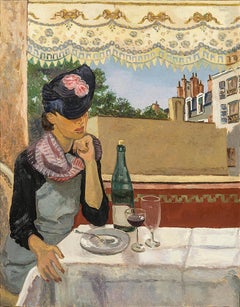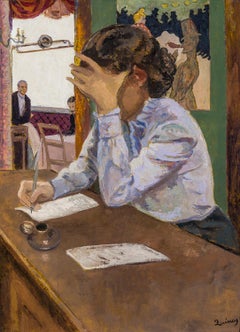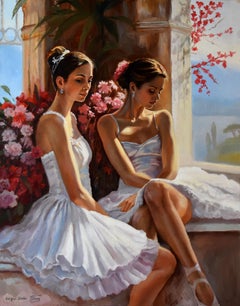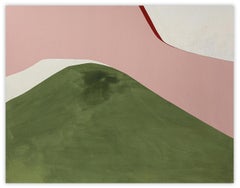Edmund Quincy Art
to
3
2
3
4
1
1
4
Overall Height
to
Overall Width
to
2
3
3
1
1
1
1
1
1
1
5
2
5
6,827
3,109
2,517
1,217
3
3
3
3
2
Artist: Edmund Quincy
Table by the Window
By Edmund Quincy
Located in New York, NY
Estate stamp (on back, on original stretcher): Estate of/ Edmund Quincy/ 1903-1997 ///
Category
20th Century American Realist Edmund Quincy Art
Materials
Canvas, Oil
The Writer
By Edmund Quincy
Located in New York, NY
Signed (lower right): Quincy
Category
20th Century American Realist Edmund Quincy Art
Materials
Canvas, Oil
Jardin des Tuileries, Paris
By Edmund Quincy
Located in New York, NY
Signed (lower right): Quincy
Category
20th Century American Realist Edmund Quincy Art
Materials
Canvas, Oil
Abstract Composition EQ1, 1962 - crayon, 66x48 cm, framed
By Edmund Quincy
Located in Nice, FR
Fusain on paper, signed lower right
Category
1960s Abstract Edmund Quincy Art
Materials
Crayon
Abstract Composition EQ2, 1962 - crayon, 66x48 cm, framed
By Edmund Quincy
Located in Nice, FR
Fusain on paper, signed lower right.
Category
1960s Abstract Edmund Quincy Art
Materials
Crayon
Related Items
The ballet friends
Located in Sempach, LU
This is a continuation of the ballet topic. In creating this piece, I immersed myself in the ethereal grace of ballet.
I used oil to capture the delicate interplay of light and sha...
Category
2010s American Realist Edmund Quincy Art
Materials
Oil, Canvas
Neige (Abstract painting)
Located in London, GB
Neige (Abstract painting)
Collage, Gouache, acrylic and oil pastel on Arches paper — Unframed
Marie de Lignerolles is an artist, designer, illustrator and colourist based in France ...
Category
2010s Abstract Edmund Quincy Art
Materials
Paper, Oil Pastel, Acrylic, Gouache
Flowers in Fog, Large Painting by F. Hasenflug
By Florence Hasenflug
Located in Long Island City, NY
Artist: Florence Hasenflug, American (1914 - 2010)
Title: Abstracted Bouquet
Year: circa 1970
Medium: Oil on Canvas, signed l.r. and verso
Size: 37.75 x 54 in. (95.89 x 137.16 cm)
Fr...
Category
1970s American Realist Edmund Quincy Art
Materials
Oil, Canvas
'Sketching Wisconsin' original oil painting, Signed
By John Steuart Curry
Located in Milwaukee, WI
John Steuart Curry
"Sketching Wisconsin," 1946
oil on canvas
31.13 x 28 inches, canvas
39.75 x 36.75 x 2.5 inches, frame
Signed and dated lower right
Overall excellent condition
Presented in a 24-karat gold leaf hand-carved wood frame
John Steuart Curry (1897-1946) was an American regionalist painter active during the Great Depression and into World War II. He was born in Kansas on his family’s farm but went on to study art in Chicago, Paris and New York as young man. In Paris, he was exposed to the work of masters such as Peter Paul Rubens, Eugène Delacroix and Jacques-Louis David. As he matured, his work showed the influence of these masters, especially in his compositional decisions. Like the two other Midwestern regionalist artists that are most often grouped with him, Grant Wood (American, 1891-1942) and Thomas Hart Benton (American, 1889-1975), Curry was interested in representational works containing distinctly American subject matter. This was contrary to the popular art at the time, which was moving closer and closer to abstraction and individual expression.
Sketching Wisconsin is an oil painting completed in 1946, the last year of John Steuart Curry’s life, during which time he was the artist-in-residence at the University of Wisconsin in Madison. The painting is significant in Curry’s body of work both as a very revealing self-portrait, and as a landscape that clearly and sensitively depicts the scenery of southern Wisconsin near Madison. It is also a portrait of the artist’s second wife, Kathleen Gould Curry, and is unique in that it contains a ‘picture within a picture,’ a compositional element that many early painting masters used to draw the eye of the viewer. This particular artwork adds a new twist to this theme: Curry’s wife is creating essentially the same painting the viewer is looking at when viewing Sketching Wisconsin.
The triangular composition of the figures in the foreground immediately brings focus to a younger Curry, whose head penetrates the horizon line and whose gaze looks out towards the viewer. The eye then moves down to Mrs. Curry, who, seated on a folding stool and with her hand raised to paint the canvas on the easel before her, anchors the triangular composition. The shape is repeated in the legs of the stool and the easel. Behind the two figures, stripes of furrowed fields fall away gently down the hillside to a farmstead and small lake below. Beyond the lake, patches of field and forest rise and fall into the distance, and eventually give way to blue hills.
Here, Curry has subverted the traditional artist’s self-portrait by portraying himself as a farmer first and an artist second. He rejects what he sees as an elitist art world of the East Coast and Europe. In this self-portrait he depicts himself without any pretense or the instruments of his profession and with a red tractor standing in the field behind him as if he was taking a break from the field work. Here, Curry’s wife symbolizes John Steuart Curry’s identity as an artist. Compared with a self-portrait of the artist completed a decade earlier, this work shows a marked departure from how the artist previously presented and viewed himself. In the earlier portrait, Curry depicted himself in the studio with brushes in hand, and with some of his more recognizable and successful canvases behind him. But in Sketching Wisconsin, Curry has taken himself out of the studio and into the field, indicating a shift in the artist’s self-conception.
Sketching Wisconsin’s rural subject also expresses Curry’s populist ideals, that art could be relevant to anyone. This followed the broad educational objectives of UW’s artist-in-residence program. Curry was appointed to his position at the University of Wisconsin in 1937 and was the first person to hold any such position in the country, the purpose of which was to serve as an educational resource to the people of the state. He embraced his role at the University with zeal and not only opened the doors of his campus studio in the School of Agriculture to the community, but also spent a great deal of time traveling around the state of Wisconsin to visit rural artists who could benefit from his expertise. It was during his ten years in the program that Curry was able to put into practice his belief that art should be meaningful to the rural populace. However, during this time he also struggled with public criticism, as the dominant forces of the art market were moving away from representation. Perhaps it was Curry’s desire for public acceptance during the latter part of his career that caused him to portray himself as an Everyman in Sketching Wisconsin.
Beyond its importance as a portrait of the artist, Sketching Wisconsin is also a detailed and sensitive landscape that shows us Curry’s deep personal connection to his environment. The landscape here can be compared to Wisconsin Landscape of 1938-39 (the Metropolitan Museum of Art), which presents a similar tableau of rolling hills with a patchwork of fields. Like Wisconsin Landscape, this is an incredibly detailed and expressive depiction of a place close to the artist’s heart. This expressive landscape is certainly the result of many hours spent sketching people, animals, weather conditions and topography of Wisconsin as Curry traveled around the state. The backdrop of undulating hills and the sweeping horizon, and the emotions evoked by it, are emphatically recognizable as the ‘driftless’ area of south-central Wisconsin. But while the Metropolitan’s Wisconsin Landscape conveys a sense of uncertainty or foreboding with its dramatic spring cloudscape and alternating bands of light and dark, Sketching Wisconsin has a warm and reflective mood. The colors of the foliage indicate that it is late summer and Curry seems to look out at the viewer approvingly, as if satisfied with the fertile ground surrounding him.
The landscape in Sketching Wisconsin is also revealing of what became one of Curry’s passions while artist-in-residence at UW’s School of Agriculture – soil conservation. When Curry was a child in Kansas, he saw his father almost lose his farm and its soil to the erosion of The Dust Bowl. Therefore, he was very enthusiastic about ideas from UW’s School of Agriculture on soil conservation methods being used on Wisconsin farms. In Sketching Wisconsin, we see evidence of crop rotation methods in the terraced stripes of fields leading down the hillside away from the Curry’s and in how they alternate between cultivated and fallow fields.
Overall, Sketching Wisconsin has a warm, reflective, and comfortably pastoral atmosphere, and the perceived shift in Curry’s self-image that is evident in the portrait is a positive one. After his rise to favor in the art world in the 1930’s, and then rejection from it due to the strong beliefs presented in his art, Curry is satisfied and proud to be farmer in this self-portrait. Curry suffered from high blood...
Category
1940s American Realist Edmund Quincy Art
Materials
Canvas, Oil
H 39.75 in W 36.75 in D 2.5 in
Mid Century Portrait of Wine Enologist Claude Wolf
By Abel Warshawsky
Located in Soquel, CA
Wine Enologist Claude Wolf - Mid Century Portrait
A stately mid-century portrait of Claude Wolf (1904-1973), a vintner Enologist by Abel George Warshawsky...
Category
1950s American Realist Edmund Quincy Art
Materials
Canvas, Oil
Come See Me
Located in Ibadan, Oyo
This painting is emphasizing the situation that encompasses a youthful love story, in a situation whereby your love partner is a shy and timid type when it comes to getting people to be aware of your relationship, most especially their parents. It feels like damn he/she is at the usual spot location as expected but we can't wait to be free to experience the freedom, passion, and excitement that surrounds love scenarios.
Shipping Procedure
Ships in a well-protected tube from Nigeria
This work is unique, not a print or other type of copy.
Accompanied by a Certificate of Authenticity (Issued by the Gallery)
About Artist
Joshua Salami...
Category
21st Century and Contemporary American Realist Edmund Quincy Art
Materials
Canvas, Oil
Amaryllis
By Frédéric Choisel
Located in Burlingame, CA
‘Amaryllis', by artist Frédéric Choisel, who lives and works in Paris, France, painted this dramatic, creamy white, amaryllis flower bursting full bloom on green stalks against a dar...
Category
21st Century and Contemporary American Realist Edmund Quincy Art
Materials
Linen, Oil, Canvas
Tetris by Ali Mourabet, Contemporary Cityscape, Aerial View Art, Original art
Located in Deddington, GB
Tetris by Ali Mourabet [2021]
original and hand signed by the artist
Acrylic on canvas
Image size: H:80 cm x W:60 cm
Complete Size of Unframed Work: H:80 cm x W:60 cm x D:2.5cm
Sold...
Category
21st Century and Contemporary American Realist Edmund Quincy Art
Materials
Canvas, Oil
H 31.5 in W 23.63 in D 0.99 in
Balance (Abstract painting)
By Adrienn Krahl
Located in London, GB
Ink, oil pastel and charcoal on paper - Unframed.
Artwork exclusive to IdeelArt.
Adrienn Krahl’s paintings express a profound sense of drama and emotional weight. Krahl works in a...
Category
2010s Abstract Edmund Quincy Art
Materials
Paper, Charcoal, Oil Pastel, Ink
American Portrait Painting of a Gentleman of the Verplanck Family
Located in Houston, TX
The painting features a 3/4 bust portrait of a gentleman from the Verplanck family of Orange County, New York. The painting shows a young man seated for her portrait in a fine black ...
Category
1820s American Realist Edmund Quincy Art
Materials
Oil, Canvas
"Hooked, " back view of figure, contemporary oil paint red & black colors
By Audrey Anastasi
Located in Brooklyn, NY
Oil on canvas
STATEMENT by AUDREY ANASTASI:
Considering myself primarily a feminist artist, painting other women, most of my work focuses on the human face, figures, animals and natu...
Category
2010s American Realist Edmund Quincy Art
Materials
Oil, Canvas
Plantation Scene
Located in Austin, TX
A scene of a plantation in the mid 20th century by Charles Shaw.
Charles William Shaw was a multifaceted American Postwar & Contemporary artist from Austin, Texas. Primarily known f...
Category
Late 20th Century American Realist Edmund Quincy Art
Materials
Canvas, Oil
Edmund Quincy art for sale on 1stDibs.
Find a wide variety of authentic Edmund Quincy art available for sale on 1stDibs. You can also browse by medium to find art by Edmund Quincy in canvas, fabric, oil paint and more. Much of the original work by this artist or collective was created during the 20th century and is mostly associated with the abstract style. Not every interior allows for large Edmund Quincy art, so small editions measuring 16 inches across are available. Customers who are interested in this artist might also find the work of Irene Rice Pereira, Hildegarde Haas, and Daniel Ralph Celentano. Edmund Quincy art prices can differ depending upon medium, time period and other attributes. On 1stDibs, the price for these items starts at $1,621 and tops out at $36,000, while the average work can sell for $17,500.




